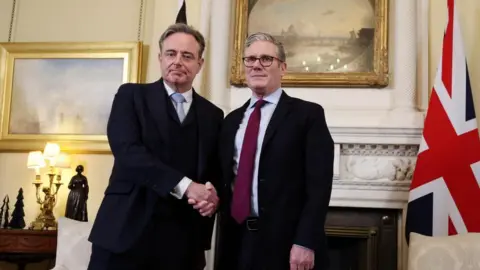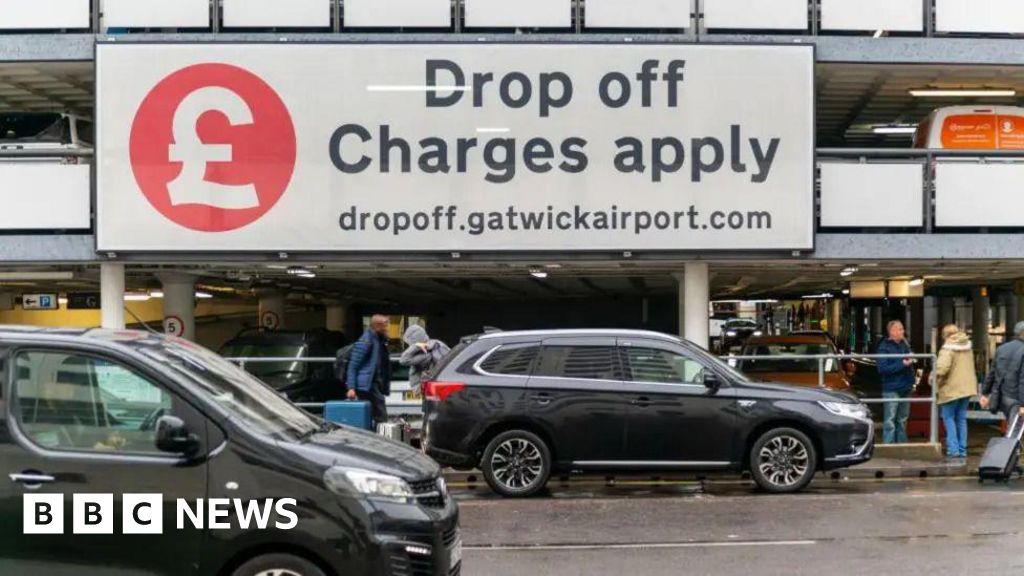Business
FTSE 100 hits record high after optimistic UK economic reports

The FTSE 100 hit another record peak on Friday fuelled by weaker-than-expected US inflation data, optimistic UK economic reports and strong results from NatWest.
The FTSE 100 index closed up 67.05 points, 0.7%, at 9,645.62, a new record close.
The FTSE 250 ended 167.61 points higher, 0.8%, at 22,529.02 and the AIM All-Share advanced 1.77 points, 0.2%, at 777.06.
For the week, the FTSE 100 rose 3.1%, the FTSE 250 advanced 3.4% and the AIM All-Share went up 0.7%.
In Europe on Friday, the CAC 40 in Paris ended flat, while the DAX 40 in Frankfurt closed up 0.1%.
Stocks in New York were sharply higher at the time of the London close. The Dow Jones Industrial Average was up 1.2%, the S&P 500 was 1.0% higher, and the Nasdaq Composite advanced 1.3%.
The yield on the US 10-year Treasury was quoted at 4.00%, unchanged from Thursday. The yield on the US 30-year Treasury stood at 4.58%, also flat from Thursday.
After a sluggish start, blue chips in London pushed ahead after US consumer price inflation accelerated at a slower pace than expected in September.
The delayed numbers from the Bureau of Labour Statistics showed the annual consumer price inflation rate was 3.0% in September, picking up speed from 2.9% in August.
But the reading was short of the FXStreet-cited consensus of 3.1%.
Core CPI, which excludes more volatile food and energy costs, rose 0.2% month-on-month, and 3.0% year-on-year. It had been expected to hold steady at August’s 3.1% level.
The figures were seen as giving the green light for the US Federal Reserve to lower rates at next week’s Federal Open Market Committee (FOMC) meeting. A quarter point cut is expected.
Analysts at Wells Fargo said: “Today’s softer-than-expected CPI data should lock the FOMC into a 25 (basis points) rate cut at its meeting next week. That said, today’s data were not so soft that the committee can sound the all clear on inflation.”
Economists think US inflation could remain “sticky” in 2026 due to the ongoing impact of tariffs and that this could have implications for future interest rate decisions.
Felix Schmidt, at Berenberg, thinks elevated inflation will make it difficult for the Fed to lower the key interest rate again beyond its October meeting.
In the UK, there was a welcome surprise from retail sales data which rose 0.5% in September, defying forecasts for a 0.2% fall.
Danni Hewson, AJ Bell head of financial analysis, said the figures should bring “cautious optimism” ahead of the sector’s most important shopping period, with Black Friday and Christmas looming.
Adding to the positive tone, flash PMI data showed business activity in the UK expanded at a faster pace in October, led by a rebound in manufacturing. The S&P Global flash composite output index climbed to 51.1 points, exceeding both the 50 no-change threshold and expectations for 50.6.
September’s reading had slipped to 50.1 points. The latest data showed the slowest pace of job cuts since May and the weakest input price inflation since November 2024.
In addition, consumer confidence increased marginally in October as shoppers look to Black Friday, despite nervousness around the upcoming Budget, figures showed.
GfK’s long-running consumer confidence index increased by two points, although it still languishes at minus 17.
The increase was largely driven by a four-point rise in the index’s major purchase marker, an indicator of confidence in buying big-ticket items, to minus 12, a nine-point improvement on last October.
The pound was quoted lower at 1.3301 dollars at the time of the London equity market close on Friday, compared to 1.3323 on Thursday.
The euro stood at 1.1631 dollars , up compared to 1.1609.
On the FTSE 100, it was nip-and-tuck between NatWest and London Stock Exchange Group for top billing, with the two swapping places as the trading day progressed.
Lender NatWest eventually won out, rising 4.9%, and hitting a 15-year high as the bank lifted its annual guidance and said profit in its third quarter jumped by around a third.
The Edinburgh-based lender reported third quarter pretax profit of £2.18 billion, a rise of 30% from £1.67 billion a year prior. Total income improved 16% to £4.33 billion from £3.74 billion.
London Stock Exchange Group took the silver medal, advancing 4.8%, after Thursday’s well-received trading update.
Elsewhere, the retail sales surprise and an upgrade helped do-it-yourself retailer Kingfisher, which rose 1.9%.
RBC Capital Markets raised the B&Q owner to “outperform” from “sector perform” on hopes that growth opportunities for Kingfisher in the UK and Poland, would provide upside to longer-term sales forecasts.
On the FTSE 250, WH Smith rose 4.2% as Peel Hunt upgraded to “buy” from “hold”, after being downgraded by Barclays on Thursday.
Next month, the Swindon-based company is expected to disclose findings into an investigation of its US business following an understatement of profit.
But Peel Hunt thinks even in a scenario that the US is worth “literally nothing”, the “shares are still worth owning” for its other divisions.
Brent oil traded at 66.56 dollars a barrel, up from 65.75 late Thursday. Gold traded at 4,125.47 dollars an ounce on Friday, down from 4,146.49 on Thursday.
The biggest risers on the FTSE 100 were NatWest Group, up 26.8 pence at 572.4p, London Stock Exchange Group, up 450.0p at 9,799.0p, Tesco, up 9.8p at 455.4p, Next, up 280.0p at 13,435.0p and Polar Capital Technology Trust, up 8.5p at 450.0p.
The biggest fallers on the FTSE 100 were GSK, down 26.5p at 1,620.0p, Airtel Africa, down 2.4p at 228.0p, Hikma Pharmaceuticals, down 17.0p at 1,753.0p, Diageo, down 15.0p at 1,811.0p and LondonMetric Property, down 1.6p at 196.9p.
Contributed by Alliance News
Business
EU backs indefinite freeze on Russia’s frozen cash ahead of big loan plan for Ukraine

Paul KirbyEurope digital editor
 Thierry Monasse/Getty Images
Thierry Monasse/Getty ImagesEuropean Union governments have agreed to immobilise indefinitely Russian assets of up to €210bn (£185bn) that have been frozen in the EU since the start of Russia’s full-scale invasion of Ukraine.
Most of Moscow’s cash is held in Belgian bank Euroclear, and European leaders are hoping to agree a deal at next week’s crunch EU summit that would use the money for a loan to help Kyiv fund its military and economy.
After almost four years of Russia’s full-scale war Ukraine is running out of cash, and needs an estimated €135.7bn (£119bn; $159bn) over the next two years.
Europe aims to provide two-thirds of that, but Russian officials accuse the EU of theft.
The Russian Central Bank said on Friday it was suing Belgian bank Euroclear in a Moscow court, in response to the EU loan plan.
‘Only fair’ to use Russia’s assets
Russia’s assets in the EU were frozen within days of the full-scale invasion of Ukraine in February 2022, and €185bn of that is held by Euroclear.
The EU and Ukraine argue that money should be used to rebuild what Russia has destroyed: Brussels calls it a “reparations loan” and has come up with a plan to prop up Ukraine’s economy to the tune of €90bn.
“It’s only fair that Russia’s frozen assets should be used to rebuild what Russia has destroyed – and that money then becomes ours,” says Ukraine’s Volodymyr Zelensky.
German Chancellor Friedrich Merz says the assets will “enable Ukraine to protect itself effectively against future Russian attacks”.
Russia’s court action was expected in Brussels and European Economic Commissioner Valdis Dombrovskis said on Friday that EU financial institutions were “fully protected” from legal proceedings.
But it is not just Moscow that is unhappy.
Belgium is worried it will be saddled with an enormous bill if it all goes wrong and Euroclear chief executive Valérie Urbain says using it could “destabilise the international financial system”.
Euroclear also has an estimated €16-17bn immobilised in Russia.
Belgian Prime Minister Bart De Wever has set the EU a series of “rational, reasonable, and justified conditions” before he will accept the reparations plan, and he has refused to rule out legal action if it “poses significant risks” for his country.
 EPA/Shutterstock
EPA/ShutterstockWhat is the EU’s plan?
The EU is working to the wire ahead of next Thursday’s summit to come up with a solution that Belgium can accept.
Until now the EU has held off touching the assets themselves directly but since last year has paid the “windfall profits” from them to Ukraine. In 2024 that was €3.7bn. Legally using the interest is seen as safe as Russia is under sanction and the proceeds are not Russian sovereign property.
But international military aid for Ukraine has slipped dramatically in 2025, and Europe has struggled to make up the shortfall left by the US decision to all but stop funding Ukraine under President Donald Trump.
There are currently two EU proposals aimed at providing Ukraine with €90bn, to cover two-thirds of its funding needs.
One is to raise the money on capital markets, backed by the EU budget as a guarantee. This is Belgium’s preferred option but it requires a unanimous vote by EU leaders and that would be difficult when Hungary and Slovakia object to funding Ukraine’s military.
That leaves loaning Ukraine cash from the Russian assets, which were originally held in securities but have now largely matured into cash. That money is Euroclear property held in the European Central Bank.
The EU’s executive, the European Commission, accepts Belgium has legitimate concerns and says it is confident it has dealt with them.
The plan is for Belgium to be protected with a guarantee covering all the €210bn of Russian assets in the EU.
Should Euroclear suffer a loss of its own assets in Russia, a Commission source explained that would be offset from assets belonging to Russia’s own clearing house which are in the EU.
If Russia went after Belgium itself, any ruling by a Russian court would not be recognised in the EU.
In a key development, EU ambassadors have agreed that Russia’s central bank assets held in Europe should be immobilised indefinitely.
Until now they have had to vote unanimously every six months to renew the freeze, which could have meant a repeated risk to Belgium.
The EU ambassadors used an emergency clause under Article 122 of the EU Treaties so the assets remain frozen as long as an “immediate threat to the economic interests of the union” continues, or until Russia pays war reparations to Ukraine in full.
Swedish Finance Minister Elisabeth Svantesson said the decision was an “important step in enabling more support for Ukraine and protecting our democracy”.
 Thierry Monasse/Getty Images
Thierry Monasse/Getty ImagesWhy Belgium is not yet satisfied
Belgium is adamant it remains a staunch ally of Ukraine, but sees legal risks in the plan and fears being left to handle the repercussions if things go wrong.
A usually divided political landscape in this case has rallied behind Prime Minister Bart De Wever, who is under pressure from European colleagues.
“Very important decisions” would be made by the EU in the coming week, he said during a meeting with UK Prime Minister Sir Keir Starmer in London on Friday. He added that Belgium and the UK would work together to “get the certainty that we can support Ukraine to stay a free, democratic and sovereign country”.
The EU believes it can secure sufficient guarantees for the loan itself, but Belgium fears an added risk of being exposed to extra damages or penalties.
“Belgium is a small economy. Belgian GDP is about €565bn – imagine if it would need to shoulder a €185bn bill,” says Veerle Colaert, professor of financial law at KU Leuven University.
She also believes the requirement for Euroclear to grant a loan to the EU would violate EU banking regulations.
“Banks need to comply with capital and liquidity requirements and shouldn’t put all their eggs in one basket. Now the EU is telling Euroclear to do just that.
“Why do we have these bank rules? It’s because we want banks to be stable. And if things go wrong it would fall to Belgium to bail out Euroclear. That’s another reason why it’s so important for Belgium to secure water-tight guarantees for Euroclear.”
Europe under pressure from every direction
There is no time to lose, warn seven EU member states including those closest geographically to Russia such as the Baltics, Finland and Poland. They believe the frozen assets plan is “the most financially feasible and politically realistic solution”.
“It’s a matter of destiny for us,” says leading German conservative MP Norbert Röttgen. “If we fail, I don’t know what we’ll do afterwards. That’s why we have to succeed in a week’s time”.
While Russia is adamant its money should not be touched, there are added concerns among European figures that the US may want to use Russia’s frozen billions differently, as part of its own peace plan.
Zelensky has said Ukraine is working with Europe and the US on a reconstruction fund, but he is also aware the US has been talking to Russia about future co-operation.
An early draft of the US peace plan referred to $100bn of Russia’s frozen assets being used by the US for reconstruction, with the US taking 50% of the profits and Europe adding another $100bn. The remaining assets would then be used in some kind of US-Russia joint investment project.
An EU source said the added advantage of Friday’s expected vote to immobilise Russia’s assets indefinitely made it harder for anyone to take the money away. Implicit is that the US would then have to win over a majority of EU member states to vote for a plan that would financially cost them an enormous sum.
Hungary’s Viktor Orban, seen as Russia’s closest partner in the EU, said Europe’s leaders were “placing themselves above the rules” and replacing the rule of law with the rule of bureaucrats.
Business
Shrinking economy takes toll on FTSE 100 amid ‘unsurprising surprise’

The FTSE 100’s early promise faded on Friday amid downbeat economic growth figures and fresh US tech weakness.
The FTSE 100 index closed down 54.1 points, 0.6%, at 9,649.03.
It had earlier traded as high as 9,761.47.
The FTSE 250 ended 24.45 points higher, 0.1%, at 21,876.55, and the AIM All-Share ended up 3.70 points, 0.5%, at 751.36.
For the week, the FTSE 100 fell 0.2%, the FTSE 250 declined 0.9% and the AIM All-Share dropped 0.2%.
The mood was knocked by news that the UK economy shrank in October, according to figures from the Office for National Statistics.
Gross domestic product is estimated to have fallen by 0.1% in October, the same as in September, missing the FXStreet-cited market consensus for a 0.1% rise.
Services output fell by 0.3%, while construction output fell by 0.6%.
Production output, however, climbed 1.1%.
Citi analyst Callum McLaren-Stewart called the data “an unsurprising surprise”.
“A miss in October is perhaps not the most surprising outcome.
“Pre-budget uncertainty, and particularly the degree of speculation ahead of the event, can likely explain the miss relative to forecasts,” he said.
“For households, the prospect of income tax increases (which was still very much live during October) would likely have put the brakes on consumer spending,” the Citi analyst said, while, on the business side, “the associated lack of clarity around which sectors were to be taxed, will have likely delayed/slowed investment decisions”.
Berenberg analyst Andrew Wishart fears some of the slowdown in the UK economy could be due to underlying issues and not just budget uncertainty.
“We suspect that deteriorating fundamentals rather than a budget-related setback in confidence are to blame, so a recovery seems unlikely in the near term,” Mr Wishart said.
The data was seen as cementing a quarter-point interest rate cut at next week’s Bank of England Monetary Policy Committee meeting.
“Not that it was in any doubt at all, but today’s data essentially guarantees that the Bank of England will slash rates again next week.
“The focus will instead be on the guidance for rates in 2026.
“Any dovish undertones that hint at further easing ahead could bode ill for the pound,” Ebury analyst Matthew Ryan said.
Mr McLaren-Stewart agrees the data “clearly supports the consensus case for a cut”.
“However, we anticipate the (BoE) will be obliged to cut lower than currently priced in 2026, necessitating a terminal rate below 3%, supported by weaker GDP outlook,” he added.
Sterling fell back after the figures, after rallying in recent days.
The pound was quoted lower at 1.3356 US dollars at the time of the London equities close on Friday, compared to 1.3416 US dollars on Thursday.
The euro stood at 1.1739 US dollars, down against 1.1746 US dollars.
Against the yen, the dollar was trading higher at 155.69 yen compared to 155.24.
In Europe on Friday, the CAC 40 in Paris closed down 0.1%, while the DAX 40 in Frankfurt ended 0.5% lower.
Stocks in New York were lower at the time of the London equity close.
The Dow Jones Industrial Average was down 0.7%, the S&P 500 index was 1.4% lower, while the Nasdaq Composite was down 2.1%.
Technology stocks were firmly in the red once more as Broadcom slid 11% after results failed to match lofty expectations, while Oracle fell a further 4.6%.
The yield on the US 10-year Treasury was quoted at 4.19%, stretched from 4.12% on Thursday.
The yield on the US 30-year Treasury was at 4.86%, widened from 4.77%.
Supporting the dollar and pushing yields higher, comments from two officials who voted against the Federal Reserve’s decision to lower interest rates this week.
Chicago Fed President Austan Goolsbee had joined Kansas City Fed President Jeffrey Schmid in pushing to keep rates unchanged instead at the central bank’s two-day policy meeting, which ended on Wednesday.
“I believe we should have waited to get more data, especially about inflation, before lowering rates further,” said Mr Goolsbee in a statement Friday.
In a separate statement, Mr Schmid, who also pushed for no rate cut at the Fed’s October meeting, said: “Right now, I see an economy that is showing momentum and inflation that is too hot, suggesting that policy is not overly restrictive.”
In addition, Federal Reserve Bank of Cleveland President Beth Hammack said she would prefer interest rates to be slightly more restrictive to keep putting pressure on inflation, which is still running too high.
Back in London, InterContinental Hotels Group rose 2.3% as Jefferies upgraded to “buy” from “hold”‘, but Whitbread dropped 2.2% as the broker moved the Premier Inn owner the other way, to “hold” from “buy”.
Elsewhere, 1Spatial soared 45% after agreeing in principle to a proposed £87.1 million offer from VertiGIS, a portfolio company of London-based private equity firm Battery Ventures.
The Cambridge, England-based location master data management software company said the cash bid would value each 1Spatial share at 73 pence.
VertiGIS confirmed that it has completed commercial due diligence, has a clear understanding of the 1Spatial business and requires only limited confirmatory diligence to proceed to making a firm offer.
But Card Factory plummeted 27% after cutting its profit guidance as it said weak high-street retail footfall hurt its UK store sales performance.
The Wakefield, England-based greeting cards, gifts and celebration merchandise retailer said it expects adjusted pretax profit of between £55 million and £60 million for financial 2026, which ends on January 31, if current trading trends persist.
This is lower than the company’s previous guidance, which was for mid-to-high single-digit-percentage growth in adjusted pretax profit from £66.0 million in financial 2025, roughly £70 million.
Card Factory attributed weak consumer confidence to the lower high street footfall, which has persisted into its “most important” trading period.
Brent oil was quoted at 61.30 dollars a barrel at the time of the London equities close on Friday, up from 60.91 late on Thursday.
Gold was quoted at 4,291.08 dollars an ounce on Friday, higher against 4,254.97.
The biggest risers on the FTSE 100 were Burberry, up 54.50 pence at 1272.5p, Ashtead Group, up 128.0p at 5,138.0p, BT Group, up 3.7p at 180.5p, Intercontinental Hotels Group, up 185.0p at 10,235.0p and Fresnillo, up 46.0p at 2,904.0p.
The biggest fallers on the FTSE 100 were St James’s Place, down 49.0p at 1,316.5p, British American Tobacco, down 146.0p at 4,238.0p, Anglo American, down 80.0p at 2,817.0p, Weir, down 80.0p at 2,856.0p and Imperial Brands, down 86.0p at 3,179.0p.
Monday’s economic calendar has CPI figures in Canada.
Later in the week, interest rate decisions are due in Europe, Japan and the UK. In addition, US nonfarm payrolls figures will be released, plus UK and US inflation and retail sales data.
Next week’s UK corporate calendar has delayed full-year results from travel retailer WH Smith and half-year numbers from electricals retailer Currys.
Contributed by Alliance News.
Business
Gatwick Airport’s drop-off fee rises to £10

Gatwick Airport is increasing the price of its drop-off zones by £3, bringing the minimum charge to £10.
The fee to allow drivers to stop outside the terminal for 10 minutes is to increase on 6 January.
The airport said the increase was “not a decision we have taken lightly” and blamed “a number of increasing costs, including a more than doubling of our business rates”.
Rod Dennis, RAC senior policy officer, said: “The words ‘Happy New Year’ are unlikely to be uttered by drivers dropping off friends and family at Gatwick in January.”
He added: “A more than 40% increase in the cost to drop-off is the largest we’ve ever seen and represents a doubling of the fee since it first came in.”
Southend Airport charges £7 for drop-off of up to five minutes, but that increases to £15 for between five and thirty minutes.
A drop-off fee of £5 was introduced at Gatwick in March 2021.
That increased to £6 in 2024, with the cost rising again to £7 in May.
A Gatwick spokesperson said: “This increase in the drop-off charge is not a decision we have taken lightly, however, we are facing a number of increasing costs, including a more than doubling of our business rates.
“The increase in the drop-off charge will support wider efforts to encourage greater use of public transport, helping limit the number of cars and reduce congestion at the entrance to our terminals, alongside funding a number of sustainable transport initiatives.”
They added that passengers can be dropped off without charge in long-stay car parks and catch a free shuttle bus to terminals.
Blue Badge holders remain exempt from the charge.
A government spokesperson said: “Airports are responsible for setting their own parking terms but must follow consumer law and justify their charges.
“We’re delivering a £4.3bn support package to cap business rates bill increases at 30% before other reliefs for the largest properties, including airports.
“Without intervention those would be up to 500%.”
Drop-off fees are also rising at Heathrow from 1 January from £6 to £7.
London City, the UK’s last major airport without a drop-off fee, is to introduce one later this month.
Out of mainland Europe’s biggest 10 airports, only one, Schiphol in Amsterdam, charges to drop-off, according to RAC research.
-

 Politics5 days ago
Politics5 days agoThailand launches air strikes against Cambodian military: army
-

 Sports1 week ago
Sports1 week agoAustralia take control of second Ashes Test | The Express Tribune
-

 Entertainment1 week ago
Entertainment1 week agoSabrina Carpenter recalls ‘unbelievable’ experience with pal Taylor Swift
-

 Politics6 days ago
Politics6 days ago17 found dead in migrant vessel off Crete: coastguard
-

 Fashion5 days ago
Fashion5 days agoGermany’s LuxExperience appoints Francis Belin as new CEO of Mytheresa
-

 Tech1 week ago
Tech1 week agoWIRED Roundup: DOGE Isn’t Dead, Facebook Dating Is Real, and Amazon’s AI Ambitions
-

 Politics1 week ago
Politics1 week agoGen-Z battles to gain political ground after ousting ex-PM Hasina in Bangladesh
-

 Fashion1 week ago
Fashion1 week agoBangladesh’s economic outlook cautiously optimistic: Govt







